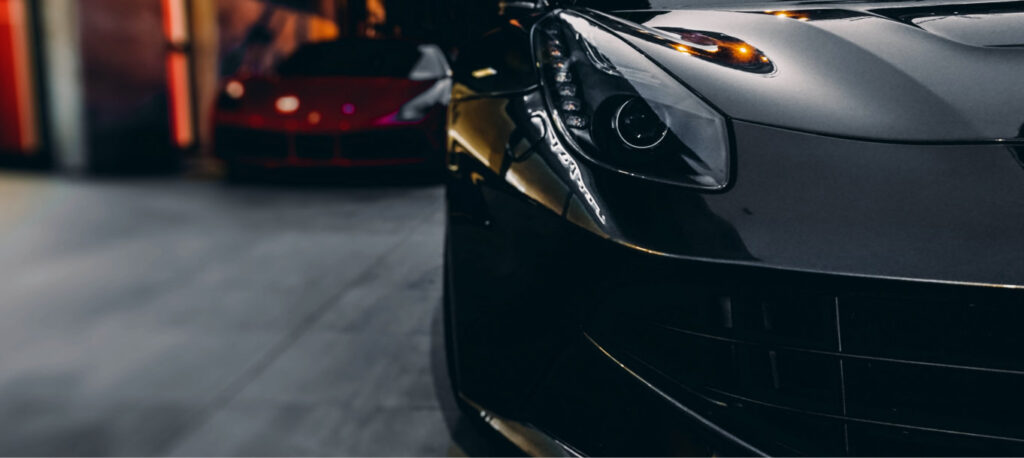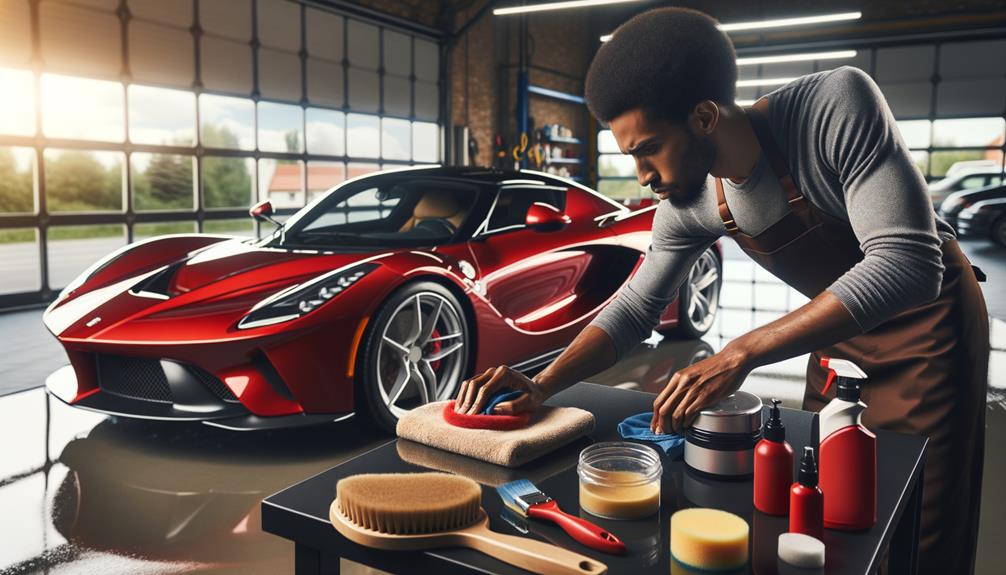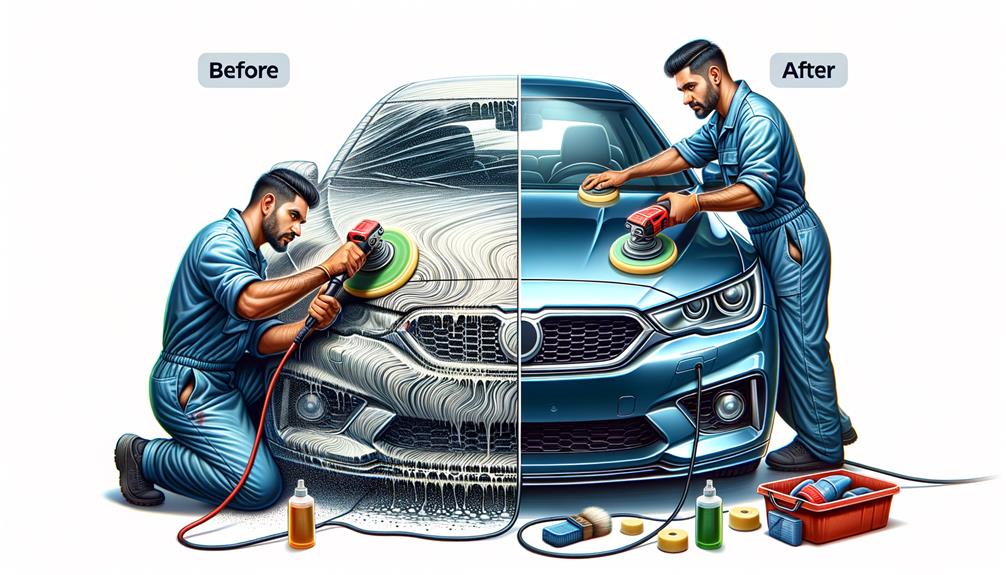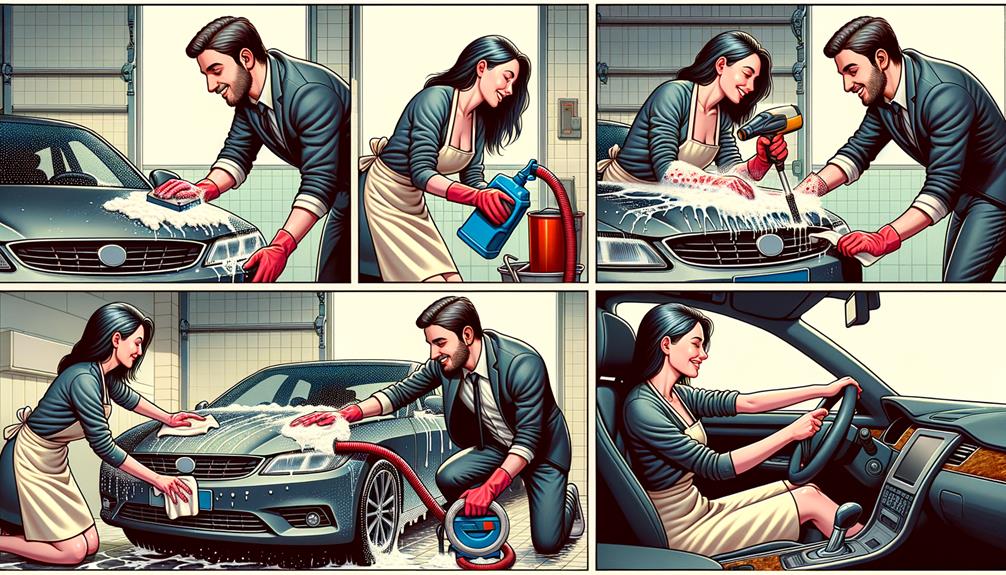
Car detailing encompasses a meticulous cleaning and reconditioning process aimed at restoring both the interior and exterior of a vehicle to a like-new state.
This process involves the use of specialised products and techniques administered by professional detailers.
Exterior detailing includes washing, claying, polishing, sealing, and waxing to remove contaminants, smooth imperfections, and enhance protection with a glossy finish.
Interior detailing involves deep cleaning of carpets, mats, upholstery, and air vents, focusing on fabric integrity and dust removal.
Paint correction, a critical component, addresses surface scratches and imperfections to preserve the vehicle’s aesthetic and protective paint layer.
Further exploration reveals the extended benefits and methodology behind these procedures.
Quick Summary
- Car detailing is a comprehensive cleaning and reconditioning process for both a vehicle’s interior and exterior.
- It aims to restore the car to a like-new condition, enhancing its aesthetic appeal and longevity.
- The process includes steps like washing, claying, polishing, and waxing the exterior, along with interior vacuuming and upholstery cleaning.
- Detailing helps preserve the vehicle’s value, protects paint and interior surfaces, and can extend the overall lifespan of the car.
- Professional detailers use specialised products and techniques to tackle tough stains and imperfections, ensuring thorough cleanliness and preservation.
Definition of Car Detailing
Car detailing is a thorough cleaning and reconditioning process aimed at restoring both the interior and exterior of a vehicle to a like-new condition.
This meticulous procedure not only revitalises the appearance of the car but also serves as a vital component of thorough car care essentials.
By employing specialised products and advanced techniques, professional detailers are able to deeply cleanse and protect various surfaces of the vehicle, from the upholstery to the engine bay.
The detailing benefits extend greatly beyond mere aesthetics; they preserve the vehicle’s value and longevity.
Each step is carefully executed to make certain that every nook and cranny, visible and hidden, receives meticulous attention, thereby maintaining the car’s pristine condition and safeguarding the owner’s investment.
Importance of Car Detailing
Furthermore, car detailing plays a pivotal role in safeguarding a vehicle‘s paint and interior surfaces against the adverse effects of wear and tear.
The benefits of regular detailing are manifold; it not only preserves a car’s aesthetic appeal and operational integrity but also bolsters its resale value by maintaining its pristine condition.
Additionally, detailing is instrumental in extending the lifespan of a vehicle by averting potential damage and deterioration.
Vehicle owners experience heightened satisfaction and pride in owning a clean, well-maintained car.
In addition, by incorporating tips and tricks that target preventative care, detailing proves economically advantageous by diminishing the frequency and severity of costly repairs and replacements in the long run.
Exterior Detailing Process

Exterior detailing is a detailed process that involves multiple stages including washing, claying, polishing, sealing, and waxing to enhance and protect the vehicle’s outer surfaces.
This regimen not only focuses on aesthetics but also on exterior protection and surface restoration.
- Washing and Claying: Remove surface contaminants, such as dirt, debris, and tree sap, using specialised cleaning agents. Claying further extracts embedded particles, preparing the surface for polishing.
- Polishing: Utilises fine abrasives to smooth out imperfections and restore the paint’s original shine.
- Sealing and Waxing: Apply sealants to offer a protective layer against environmental damage, followed by wax to provide a glossy finish and additional protective barrier.
- Specialised Treatments: Address alloy wheels and tires, ensuring thorough cleanliness and restoration.
Interior Detailing Techniques
Having explored the meticulous process of exterior detailing, we now turn our attention to the equally important techniques of interior detailing.
This phase involves a thorough approach to make sure every aspect of the vehicle’s interior is not only clean but also protected.
| Component | Technique | Purpose |
|---|---|---|
| Carpets & Mats | Deep cleaning, stain repair | Remove dirt and stains, refresh |
| Upholstery | Deep cleaning, protection | Maintain fabric integrity, protect |
| Air Vents | Dusting, vacuuming | Eliminate trapped particles |
Thorough cleaning and conditioning of upholstery are essential for removing embedded dirt and ensuring the materials remain durable.
Similarly, detailed attention to air vents and window seals prevents accumulation of debris, contributing to both aesthetic appeal and longevity of the vehicle’s interior components.
Paint Correction Explained

Paint correction, a critical step in car detailing, meticulously removes imperfections such as swirl marks, scratches, and oxidation from the vehicle’s paintwork.
This process not only enhances the cosmetic appearance of a car but also contributes to the preservation of the vehicle’s paint.
Here are the key aspects:
- Common Paint Imperfections: Swirl marks, scratches, and oxidation.
- Paint Correction Methods: Includes wet-sanding, compounding, and polishing.
- Benefits of Paint Correction: Enhances gloss and clarity, resulting in a mirror-like finish.
- Solutions for Imperfections: Professional techniques restore paintwork and protect against future damage.
Detailing Tools and Products
Equipped with the right detailing tools and products, professionals can achieve superior cleanliness and protection for various car surfaces.
Essential tools like microfiber towels and foam applicators facilitate precise product application, ensuring that substances such as ceramic coatings and paint sealants are evenly distributed without excess waste or damage to the surface.
Detailing brushes and dual-action polishers are critical for meticulous cleaning and polishing, pivotal in paint correction processes.
Tool maintenance is paramount; regular cleaning and proper storage of tools like rotary and orbital polishers prolong their life and maintain their effectiveness.
Additionally, utilising advanced tools such as paint thickness gauges and colour-matching lights enhances the accuracy of the detailing work, leading to flawless results.
Steps for DIY Detailing

DIY car detailing is a meticulous process that involves several key steps: washing, claying, polishing, sealing, and waxing the exterior to preserve and enhance the vehicle’s appearance.
To guarantee success and avoid common DIY detailing mistakes, follow these structured steps:
- Washing: Remove dirt and debris with a high-quality shampoo. Employ two buckets—one for clean soapy water and another for rinsing your mitt—to avoid scratching the paint.
- Claying: Use a clay bar to remove embedded surface contaminants, which prepares the paint for polishing.
- Polishing: Apply a polishing compound to remove fine scratches and swirls, enhancing the paint’s shine.
- Sealing/Waxing: Seal the paint to protect it, then apply carnauba wax for a glossy finish.
Professional Detailing Services
Professional car detailing near you offers a thorough approach to vehicle maintenance, meticulously cleaning and reconditioning both the interior and exterior to restore and enhance the overall appearance and functionality.
These services employ advanced professional techniques involving high-quality products designed to tackle specific detailing challenges.
Exterior treatments typically include a sequence of washing, claying, polishing, sealing, and waxing, each step carefully executed to maximise the vehicle’s aesthetic appeal.
On the interior, detailers focus on detailed methods like vacuuming, scrubbing, steam cleaning, glass cleaning, and leather treatment, ensuring a pristine environment.
Detailing benefits extend beyond mere aesthetics, incorporating paint correction, ceramic coatings, and paint protection films (PPF) to safeguard the vehicle’s finish from environmental elements and everyday wear.
Frequently Asked Questions
What Is Included in a Full Detail of a Car?
A thorough detail of a car encompasses detailed interior sanitisation and exterior polishing, including deep cleaning of upholstery, carpets, and surfaces, alongside meticulous treatment of the vehicle’s paintwork, wheels, and tires.
What Is Meant by Car Detailing?
Car detailing involves meticulous cleaning, restoration, and enhancement of a vehicle using professional techniques. This process maximises detailing benefits by preserving the car’s condition and boosting its aesthetic appeal through precise, technical methods.
What Is the Difference Between Detailing and Valeting?
Detailing and valeting differ primarily in service duration and equipment used. Detailing involves longer, more intricate sessions with specialised tools for paint correction, while valeting offers quicker, general cleaning with standard equipment.
How Much Does Car Detailing Cost in the UK?
Car detailing costs in the UK typically range from £129 for basic services to £900 for all-inclusive packages. Prices may vary due to regional pricing trends and seasonal discounts.
Conclusion
To sum up, car detailing is a thorough process that enhances and maintains the aesthetic and functional aspects of vehicles.
Through meticulous exterior and interior detailing, as well as paint correction, the vehicle’s appearance and longevity are greatly improved.
Utilising specialised tools and products, both DIY enthusiasts and professional services can achieve exceptional results.
Therefore, car detailing is not just a way of maintaining a vehicle’s appeal but also an important practice for preserving its value and operational integrity.
